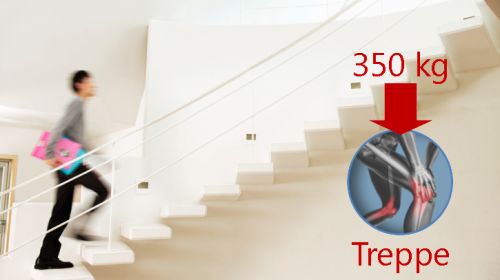Stretching the ligaments is one of the most common injuries to the joints. The cause is usually twisting, for example during sports. How to recognize a ligament stretch, how long it takes to heal and what measures you can take to prevent it.
- Stretching the ligaments very often affects the ankle and usually happens during sports.
- © iStock.com/Piyapong Thongcharoen
Due to the large forces and levers that act on joints, some ligaments are required for support and stability, which can be affected depending on the impact. This can be shown, for example, by ligament stretching on the ankle, knee or finger.
What are ligaments and what are the injuries?
Ligaments are collagen-containing, stretchy connective tissue strands that connect our bones. These fiber strands are therefore around the joints in order to stabilize and guide them.
If the ligaments are stretched beyond their natural dimensions, for example with an abrupt twisting, there is a ligament stretch (often also called ligament strain), a ligament tear (partial rupture or partial rupture) or a ligament tear (ligament rupture).
Ligament stretching is the most common ankle injury
If such a twist turns out lightly, you will get away with a ligament stretch or a ligament tear (partial rupture). A ligament stretch is also called a sprain. This most common ankle injury is usually not operated on. Multiple ligament stretching, as experienced by some athletes in their active time, can lead to instability in the ankle in the long term.
If the ankle joint fork, which consists of the tibia and fibula, is pushed apart by the ankle bone (talus) during a massive twist, a so-called syndesmosis tear can occur. Syndesmosis is a band that fixes the tibia and fibula together. If there is a tear (rupture) of more than two millimeters, ankle arthrosis can develop later. A syndesmos tear usually occurs in combination with a broken bone.
Basically, in the case of ligament injuries such as ligament stretching on the foot, the outside of the ankle is affected more often than the inside.
Symptoms of ligament stretching
Immediately after ligament stretching, the affected joint swells. This pressure makes the area of the ligaments painful.
If swelling of the foot occurs with swelling that occurs very quickly and at points, it is obvious that the ankle capsule has also been damaged. Immediately after the trauma, walking ability is significantly reduced or even impossible.
The most common causes of ligament stretching
The cause of a tape stretch is usually tensile loads that exceed the strength of the tape. They usually arise from accidents while doing sports, in traffic, or from careless movements that result in hyperextension or bending in the joint.
Broken bones near the joints are another common cause of ligament stretching and other ligament injuries. On the one hand, sharp-edged bone fragments can damage ligaments. On the other hand, the joint can be dislocated in the event of an accident (luxation), which automatically means an injury to the ligaments that stabilize the joint.
In many cases, depending on the function of the individual ligaments, there are typical injury sequences that make the doctor suspect certain injury patterns based on the course of the accident.
Bands are extremely firm. Usually, ligament injuries occur only after strong force. For example, if ligaments are damaged by metabolic disorders or previous injuries, damage can also occur under normal stress. Lime deposits in the belt apparatus, the cause of which is mostly unknown, are widespread. A long-term vitamin D deficiency can also reduce the strength of ligaments.
Ankle ligament stretching
The shape of the ankle bone means that the ligaments of the upper ankle are subjected to strong forces, particularly when the foot is stretched and the inner or outer rotation is simultaneous, and are therefore prone to injury.
In addition to the stop-and-go sports, everyday movements can also lead to ligament stretching. So high heels require a general extension of the foot. If the foot bends sideways in this position, injuries to the inner or outer ligament can easily occur. Likewise, ligament injuries can occur if the foot slides sideways from an edge, such as from the sidewalk.
Examinations for the diagnosis of ligament stretching
The doctor asks from the medical history whether the patient has known ligament instability at the affected joint. This is not uncommon. It often results from repeated stretching, such as in the ankle or knee, or poorly healed older ligament injuries.
During the tactile examination, the doctor tries to feel the course of the ligaments in order to infer possible tear injuries. He also tests whether the foot can be bent at an unusual angle to the side and whether the foot can be moved forwards or backwards in the upper ankle joint (drawer test). The mobility of the joint can be checked under simultaneous ultrasound examination. MRI and CT are only used in exceptional cases.
Treat ligament elongation
When treating ligament stretching, primary medical care through immobilization and cooling is essential. If the ligament of the ankle or knee is stretched, the affected foot or leg should be raised. Constant cooling of the area and a bandage can counteract the swelling. The joint should be loaded as little as possible.
Course and healing of ligament injuries on the ankle
Ankle ligament stretching is often no longer particularly painful after just a few days. Most of those affected can usually put their joint back to full stress after about two weeks.
Until then, the joint should be subjected to as little stress as possible in order not to delay the healing process. The more consistently the joint is protected, the shorter the healing process. Under certain circumstances, it can make sense to wait a little longer with heavy physical exertion than to be completely free of pain.
Duration and treatment for ligament stretching generally vary depending on the severity of the injury and how quickly appropriate therapy begins.
Prevent ligament stretching at the ankle with good shoes
Due to the traumatic origin, ligament injuries to the ankle can only be prevented to a limited extent. Shoes that extend over the ankles offer more protection to the ankle during activities that involve an increased risk. Athletes who have had previous injuries can support the ankles with a tape bandage.


